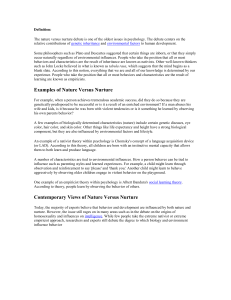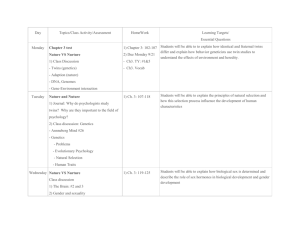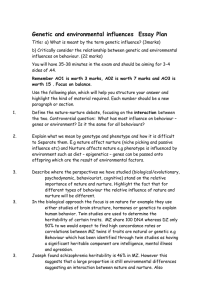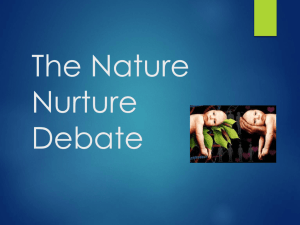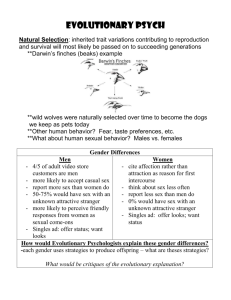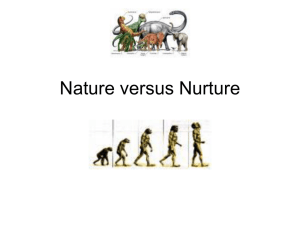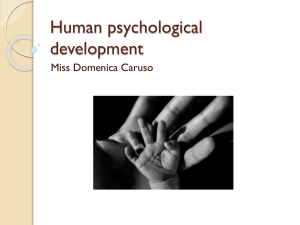The nature nurture debate
advertisement
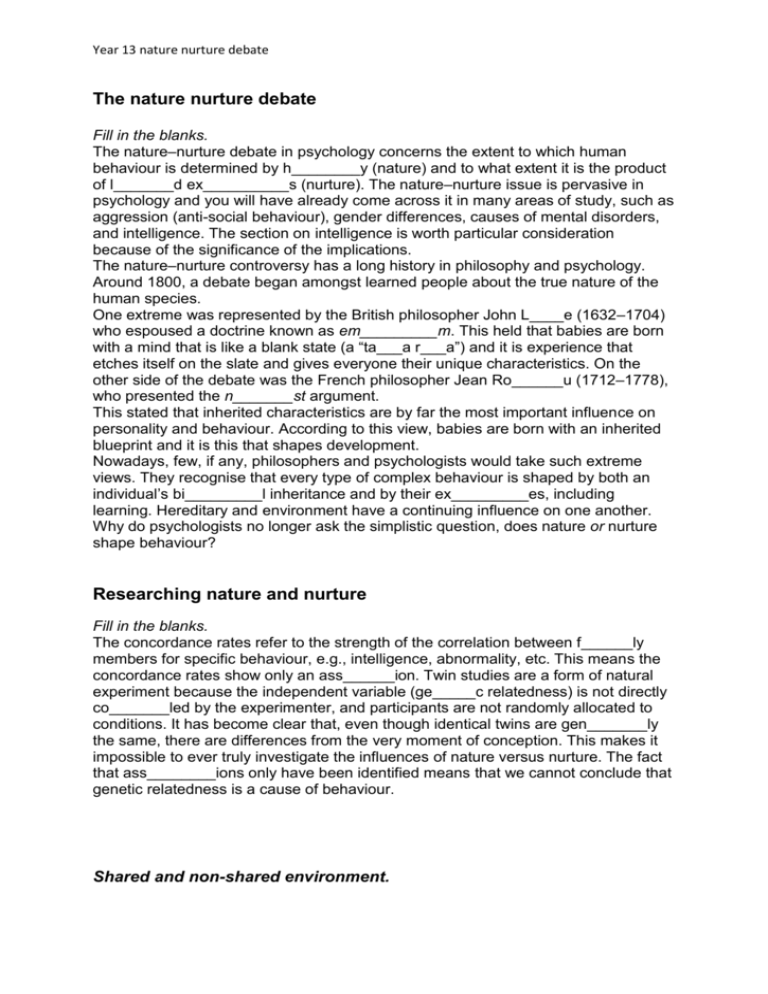
Year 13 nature nurture debate The nature nurture debate Fill in the blanks. The nature–nurture debate in psychology concerns the extent to which human behaviour is determined by h________y (nature) and to what extent it is the product of l_______d ex__________s (nurture). The nature–nurture issue is pervasive in psychology and you will have already come across it in many areas of study, such as aggression (anti-social behaviour), gender differences, causes of mental disorders, and intelligence. The section on intelligence is worth particular consideration because of the significance of the implications. The nature–nurture controversy has a long history in philosophy and psychology. Around 1800, a debate began amongst learned people about the true nature of the human species. One extreme was represented by the British philosopher John L____e (1632–1704) who espoused a doctrine known as em_________m. This held that babies are born with a mind that is like a blank state (a “ta___a r___a”) and it is experience that etches itself on the slate and gives everyone their unique characteristics. On the other side of the debate was the French philosopher Jean Ro______u (1712–1778), who presented the n_______st argument. This stated that inherited characteristics are by far the most important influence on personality and behaviour. According to this view, babies are born with an inherited blueprint and it is this that shapes development. Nowadays, few, if any, philosophers and psychologists would take such extreme views. They recognise that every type of complex behaviour is shaped by both an individual’s bi_________l inheritance and by their ex_________es, including learning. Hereditary and environment have a continuing influence on one another. Why do psychologists no longer ask the simplistic question, does nature or nurture shape behaviour? Researching nature and nurture Fill in the blanks. The concordance rates refer to the strength of the correlation between f______ly members for specific behaviour, e.g., intelligence, abnormality, etc. This means the concordance rates show only an ass______ion. Twin studies are a form of natural experiment because the independent variable (ge_____c relatedness) is not directly co_______led by the experimenter, and participants are not randomly allocated to conditions. It has become clear that, even though identical twins are gen_______ly the same, there are differences from the very moment of conception. This makes it impossible to ever truly investigate the influences of nature versus nurture. The fact that ass________ions only have been identified means that we cannot conclude that genetic relatedness is a cause of behaviour. Shared and non-shared environment. Year 13 nature nurture debate Harris (1995) raises the question about why siblings and twins, who are raised in the same environments and who have significant g______ic similarity, can turn out so differently. Research indicates that about 50% of the variation in most adult characteristics is due to ge______c factors. The rest must be envi_________al, but this cannot be the shared environment, because otherwise twins and siblings would be more si_____ar, and so the non-shared environment has been proposed to explain the variation. The n___-s______d e___________ cannot be the micro-environment of the child because this too is related to genetic factors, such as physical looks and temperament. The non-shared environment must be influences outside the child’s home. This would explain the fact that twins reared together and twins reared apart show similar correlations in behaviour. The remaining influences are not in the home, i.e., are non-shared, such as peer influences. We said earlier that the environment and heredity do not act independently of one another but interact. Consider ways in which this interaction may occur. 1. The diathesis–stress model. What is this and how does it explain the development of mental disorder? 2. Phenotype and genotype. What is the phenotype and how does it differ from the genotype? 3. The form of interaction Fill in the blanks. If g_______ and environment interact, then it useful to consider ways in which this interaction could occur. In recent years, behavioural geneticists have argued that our g____ may actually influence the type of e_________nt we experience. Plomin et al. (1977) identified three different kinds of interaction between n_____ and n______, described in terms of how a child may be affected by his or her environment: a. Passive heredity–environment interaction. How may the parents’ genotype be transmitted passively via the environment? b. Reactive heredity–environment interaction. How may reactions to the child’s genetic make-up affect the environment the child experiences? c. Active heredity–environment interaction. How may the child’s genetic make-up influence the environment the child seeks out?
